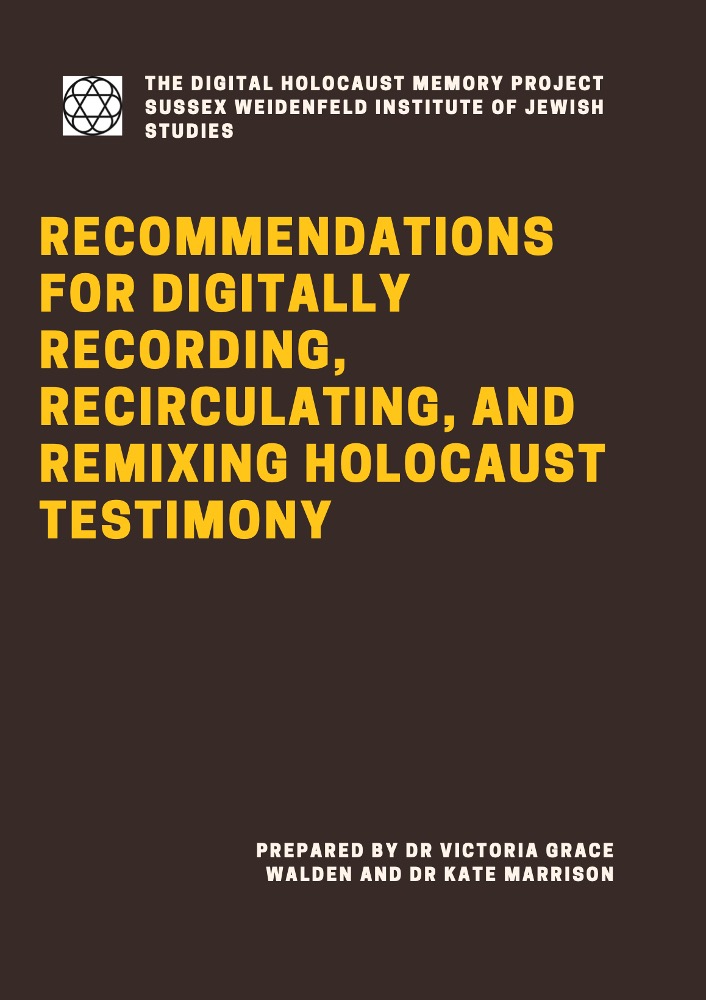
Recommendations for Digitally Recording, Recirculating and Remixing Holocaust Testimony
The recommendation reports, published as part of the Digital Holocaust Memory Project, underpin the objectives of the Landecker Digital Memory Lab. Their findings feed into all of the work that we now do.
Forward
Testimony has always raised ethical issues, especially in relation to questions of provenance, integrity, ownership, and authenticity. Nevertheless, it has become one of the most powerful sources for Holocaust education. Meeting a Holocaust survivor in- person has been a particular tenet of educational experiences. Looking forward, we face dual challenges: (1) the decline in numbers of living witnesses to the Holocaust, (2) the increasing prevalence of digital technologies. It has been somewhat taken for granted that the latter offers solutions for dealing with the former.
Media technologies have been integral to the dissemination of Holocaust testimony since the 1940s. From the attempts to smuggle out material evidence of witnessing atrocities on photographic film to the scraps of paper and writing implements used to document experiences and wishes for the future, from the Oneg Shabbat archives of the Warsaw Ghetto to the ‘Scrolls of Auschwitz’. It is however in the immediate post- war period with Boder’s wire recordings that spoken testimony of events after the fact began to be recorded at scale. Some survivors later chose to publish their testimonies in memoir form. Then, in 1979, the Holocaust Survivors Film Project launched which developed into the Fortunoff Archives at Yale University. At Yale, audio-video testimonies were captured on tape, which not only preserved the speech patterns alongside narrative content of testimonies, but gestures and body language also. In moments of silence, viewers of testimony could now see the testimony-giver’s body, any emotional reaction, and their gaze. There was a range of academic writing (from Lawrence Langer to Georges Agamben and Jean-François Lyotard) that addressed the significance of these ‘silences’, in different ways.
With video then digital interventions in testimony recording, there has been increasingly attention given to the visual elements of testimonial narratives. This has been particularly demonstrated by the projects of the USC Shoah Foundation.
Starting in a similar vein to Fortunoff, with audio-visual testimonies, the Foundation (initially established by the profits for Schindler’s List (1994)), has since turned its attention to interactive interfaces (IWitness) use of machine learning (Dimensions in Testimony) and virtual reality (‘Lola’ and ‘The Last Goodbye’) and 360-degree on- location testimonies to explore the affordances that emerging technologies can offer for the sustainability of testimony into the future. Whilst of course, historical concerns about testimony will always remain, digital technologies introduce new possibilities and challenges, which needs to be better understood across the sector.
This report serves as an important first step in this work. It was created as part of the research project ‘Participatory Workshops – Co-Designing Standards for Digital Interventions in Holocaust Memory and Education’, which is one thread of the larger Digital Holocaust Memory Project at the University of Sussex.
The participatory workshops have focused on six themes, each of which brought together a different range of expertise to discuss current challenges and consider possible recommendations for the future. The themes were:
- AI and machine learning
- Digitising material evidence
- Recording, recirculating and remixing testimony Social media
- Virtual memoryscapes
- Computer games
Download the full report below: